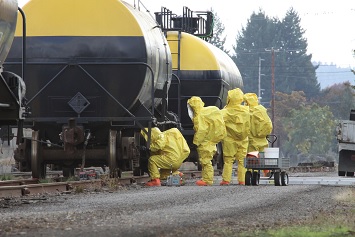OSHA has many worker protection standards, and it is not uncommon to find two or more standards addressing the same hazards in different ways. In such cases, which standard must an employer comply with?
When government agencies have overlapping standards, rules, or requirements, the underlying statute(s) may clarify which takes precedent. This type of clarification is essential where a statute allows a state to promulgate rules that are more stringent than federal rules; in such cases, the state rules take precedence. Where a statute does not provide clarification, implementing agencies typically issue guidance on which rules take precedence over others.
In a 2015 document OSHA issued to instruct its inspectors on enforcing the Hazard Communication Standard (HCS or HazCom) (29 CFR 1910.1200), OSHA notes that the general topic of hazard communication is addressed in specific standards for the general industry, shipyard employment, marine terminals, longshoring, and the construction industry. Again, when these standards address the same hazards as the HCS, the document instructs inspectors “to ensure that the employer is complying with the more stringent requirements.”
The guidance document provides multiple examples of which standard should be applied when an overlap occurs, including overlap between the HCS and EPA regulations governing hazardous waste. Below we also note examples of how the guidance instructs inspectors to determine compliance obligations when the HCS and OSHA’s standard for hazardous waste operations and emergency response ((HAZWOPER), 29 CFR 1910.120) intersect.
Employer Responsibility
The HCS requires that employers provide for worker safety by possessing information about the identities and hazards of the chemicals in the workplace and ensuring that that information is available to and understood by employees.
HAZWOPER is intended to provide protections to employees who are exposed or potentially exposed to hazardous substances, including hazardous waste, when they are engaged in specific tasks, including cleanup at uncontrolled hazardous waste sites and emergency response to a release of a hazardous substance.

Hazardous Waste Operations and Emergency Response
Following are points the guidance makes about the applicability of the HCS, as well as whether the HCS or HAZWOPER takes precedence in specific circumstances.
- Hazardous waste, as defined under the Resource Conservation and Recovery Act (RCRA), when subject to regulations issued by the EPA under that Act, is not covered by the HCS. If the hazardous waste is not regulated by the EPA, the HCS applies.
- Hazardous substances, as defined under Comprehensive Environmental Response, Compensation, and Liability Act (CERCLA or Superfund), which are the focus of remedial or removal action being conducted under CERLCA in accordance with the EPA regulations, are not covered by the HCS.
- Chemicals (other than hazardous waste and hazardous substances noted above) brought onto hazardous waste sites are covered by the HCS.
- HAZWOPER does not cover response to incidental spills that do not have the potential for becoming an emergency. Training for responding to such incidental spills would be under the HCS and would include, at a minimum, leak and spill cleanup procedures and the use of appropriate personal protective equipment (PPE).
- HAZWOPER has training requirements for emergency procedures, as does the HCS. The scope and extent of employee training regarding emergency procedures will depend on the employer’s emergency response plan. If the employer merely intends to evacuate the work area, the training in emergency procedures could be limited to, for example, information on the emergency alarm system in use at the worksite, evacuation routes, and reporting areas.
- Employees who are required to respond to spills that have the potential for becoming an emergency are covered by HAZWOPER (1910.120(q)). Therefore, in workplaces where there is a potential for emergencies, the employer’s HCS training program would have to address the HAZWOPER emergency response plan and/or emergency action plan. Training under the HCS can be adapted to encompass all required training competencies in 29 CFR 1910.1200(q)(6)(i), the first responder awareness level, and a single training could be fashioned to satisfy the requirements of both standards.
OSHA’s inspector guidance is available here.

